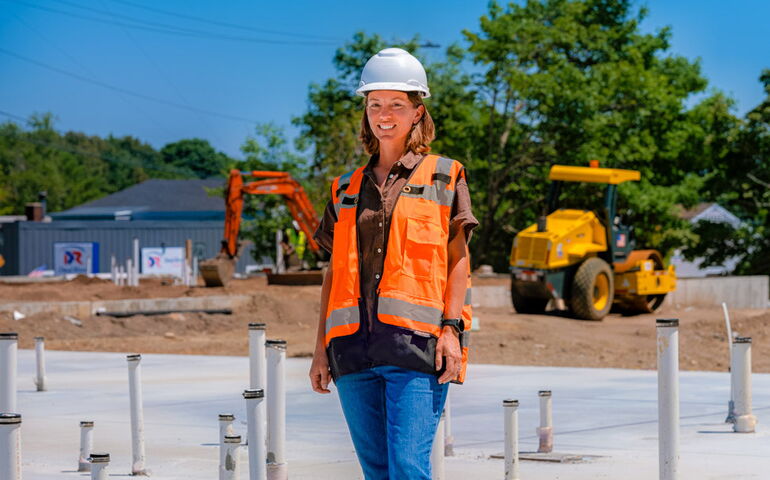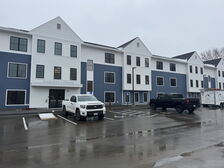
Processing Your Payment
Please do not leave this page until complete. This can take a few moments.
More affordable housing developments than ever are underway. More are needed
 Photo / David Clough
Laura Reading at Developers Collaborative says greater awareness of the need for affordable housing is driving more development, such as the collaborative’s Peasley Park project in Rockland.
Photo / David Clough
Laura Reading at Developers Collaborative says greater awareness of the need for affordable housing is driving more development, such as the collaborative’s Peasley Park project in Rockland.
In Rockland, Portland development company Developers Collaborative and Falmouth general contractor Penobscot General Contractors broke ground on Peasley Park, a $17.4 million project at 118 Maverick St. to develop 49 units of affordable senior housing.
Rents are projected to range from $622 to $801 for renters earning 60% of area median income or less, with 10 units having vouchers for populations with special needs.
It’s one of several affordable housing projects Developers Collaborative has in the pipeline, including 115 Congress St. in Belfast and 101 Hancock St. in Rumford, and consulting jobs for the Augusta Housing Authority at 18 Park St. and Malta Street.
At 25 Casco St. in Portland, Equality Community Center hired the group to develop 54 units of affordable senior housing, with supportive services for people with disabilities or those living with HIV/AIDS.
The city of Augusta also recently selected Developers Collaborative to redevelop city-owned property at 33 Union St.
“We’ve had a pretty steady flow of developments over the last 10 years,” says Laura Reading, the collaborative’s director of affordable housing. “There’s been more attention brought to the need, so there’s more attention on development.”
Hit hard
Maine’s critical need for affordable housing encompasses rentals and home ownership. Customers run the gamut from young professionals to entry-level workers to retirees.
“It’s young people who have good jobs but who in many parts of the state can’t afford to buy any house,” says Nathan Szanton, president of the Szanton Co., a Portland-based housing developer specializing in affordable housing.
“Young people are hit hard for rental housing. It’s workers all together — nurse’s aides, retail clerks, childcare workers, people working at nonprofit organizations, especially early in their careers, cooks, dishwashers, chamber maids, janitorial people — almost any entry-level job will have a hard time affording today’s rents.”
Daniel Brennan, director of MaineHousing, recalls his own experience getting out of college a few decades ago, getting a job and looking for an apartment in South Portland.

“There happened to be four or five apartments in my price range,” he says. “That doesn’t exist anymore.”
Historic production
But there’s been progress. Gov. Janet Mills and lawmakers have made housing a significant priority, sending $314 million since 2019 to MaineHousing — a primary player in the affordable housing world, as an independent state agency that bridges public and private housing finance — to encourage affordable housing production.
This has led to a historic expansion in the sector across Maine, especially in rural areas, says Brennan.
This year, MaineHousing participated in seven affordable housing developments that opened in May; 33 developments and 1,407 affordable homes are under construction and an additional 53 projects totaling 2,119 units are in pre-construction.
“There’s a lot going on,” says Brennan. “Over the last five years, there’s been the recognition that housing is a big deal in Maine and around the country.
"For many years, we had to make the case that housing belonged in the conversation at the upper levels of political strategy and resources. We don’t have to do that anymore. There seems to be a collective understanding at the federal and state level that housing is a really big deal and that we’ve got to do something.”
Supply and demand imbalance
Skyrocketing home sale prices and rental rates are due to factors such as a population influx in search of rentals and for-sale housing as a result of the pandemic, the conversion of housing stock to lucrative vacation rentals, and increasing construction costs.
Demand has outpaced supply for years, notes Szanton. The pandemic accelerated the problem.

“It’s like a game of musical chairs, where instead of 11 kids and 10 chairs, you have 600,000 households and 560,000 dwelling units,” Szanton says.
“Anytime you’ve got that imbalance, people are going to bid really hard for those dwelling units and some will get left out, and the ones who get left out are the ones who have the least money.”
MaineHousing’s development incentives include long-term financing at low or zero interest rates. Low-income housing tax credits are allocated to developers who sell them to corporate investors, with proceeds used as equity in the developer’s rental housing project. The equity lowers the mortgage needed for development. In turn, lower mortgages mean lower rents.
Another important development was the legislature’s passage in 2022 of LD 2003, which requires municipalities to permit a wider range of housing types and commits state financial and technical assistance for municipalities to support local and regional production targets.
Puzzle pieces
Bath Housing Development Corp. is building 42 units in two phases at 520 and 540 Centre St. Other affordable housing projects in Bath have included MaineHousing and the Szanton Co.’s collaboration on a project called the Uptown for tenants age 55 and older, with 42 income-restricted and 18 market-rate units.
“There’s definitely been a lot of activity,” says Debora Keller, Bath Housing’s executive director.
Statewide, there’s a long way to go.
A MaineHousing study says the state needs 84,000 new units across all income levels.
“We can set these ambitious goals, but one concern is the rapid loss of naturally occurring affordable housing,” says Keller.
For a long time, she continues, affordable housing occurred organically in existing housing stock. But a generation of local landlords are selling their properties, often to investors, she says. The result? Tenants can’t afford rents or are asked to leave.
“The 84,000 is a big number and it can be overwhelming,” says Keller. “What’s good is that we have a legislature that understands the issue and is working with the housing community. That’s what we’re optimistic about. At the same time, there are so many barriers to getting more housing built. That’s what’s concerning.”
She continues, “People understand there’s no one quick fix to this housing challenge. It takes a combination of policy changes, it takes production of new units, it takes a commitment to continuing direct assistance to people who are struggling, and it takes a commitment to preserving our existing housing stock.”
Bath, she says, is hitting all pieces of the puzzle, through activities like zoning updates, new production, direct assistance and investment in older properties.
“We’re in a really good place here,” Keller says.
Density boost
Moving through approvals in Portland is LB Development Partners’ proposed $13 million, 30-unit affordable residential building at 42 Atlantic St. in the Munjoy Hill historic district.
The development is made possible by recent changes to the city’s land use code, in response to LD 2003, that allow for 2.5 times the base zoning density for affordable housing projects. The density boost would have permitted up to 35 units on the site.
The developers, Dan Black and Carl Lakari of LB Development Partners, plan to apply for financing from MaineHousing, including 9% low-income housing tax credits and a zero-percent interest loan; plus tax increment financing from the city.
“We’re definitely seeing more affordable housing projects — or market-rate projects that include affordable units — being proposed,” says Black. “To some extent, that’s a response to public policy. Our state government and some of municipalities have made it clear that affordable housing is a priority through smart policy choices.”
Finance incentives
The Szanton Co. recently broke ground on a 63-unit affordable housing apartment building, called 45 Dougherty Court, in Portland’s Libbytown neighborhood.
Designed to LEED Silver standards, the project will include 63 one-, two- and three-bedroom units, along with a fitness center, community room, laundry room, secure indoor bike storage and EV charging stations.
The project cost is expected to be just over $27 million. Financing comes from several MaineHousing programs: 4% low-income housing tax credits bringing in $8.8 million, an interest-only, 30-year mortgage of $8.2 million, and a zero-percent mortgage of $7.4 million that will be due at year 30; plus affordable housing tax increment financing from the city. Tax increment financing defers property taxes for a specific time period.

Reserved for households earning up to 60% of area median income, rents are expected to range from $1,130 for a one-bedroom to $1,550 for a three-bedroom. In Portland currently, rentals for this type of unit at market rates would probably range from $1,900 to $2,600, Szanton says.
The Szanton Co. has built 14 affordable apartment projects throughout southern Maine and seacoast New Hampshire and consulted on 15.
“It’s a double bottom line,” says Szanton. “I feel very lucky to have found a field where I can have a positive impact on society and help meet some of our most pressing needs in terms of providing safe, decent affordable housing that people want to live in — and also make a living at it.”
Housing flow
New incentives and policies are making such projects more viable, Szanton says.
“The only way developers can afford to offer rents that are low enough for many people in our society to afford is by having some sort of subsidy involved,” he says.
“If you were to just buy a piece of land and go to a bank to borrow money to build a building, with no subsidy, you’d have to charge rents that are well over what most workers can afford.”
Maine needs more. Homes are considered affordable if the rent or cost of ownership is less than 30% of household income, says the U.S. Department of Housing and Urban Development. Today, buying and renting are unaffordable for many Mainers, according to the State of Maine Housing Production Needs Study (October 2023).
And the housing inventory — 737,800 in 2021 — is not enough. Maine needs to add 8,500 to 9,300 homes per year, twice today’s production.
“We need a housing system where all income levels are flowing nicely,” says Brennan. “Renters become homeowners. Homeowners expand their family, grow their businesses, and buy their next home. Maybe they want the nice house for a second home, then as people age they look to downsize. We want to make sure there are housing options at all those different levels.”













0 Comments